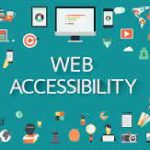Providing equal access and equal opportunity to people with disabilities is significant to create inclusive experiences. “The power of the web is in its universality. Access by everyone regardless of disability is an essential aspect,” said Tim Berners-Lee, W3C Director and Inventor of the World Wide Web. Generally, all the users have equal access to information and functionality, provided if the content is appropriately premeditated, developed and amended.
The web is a critical resource across many aspects of life. Making web content more accessible to people with disabilities is burgeoning as organizations across different verticals place a high emphasis on building inclusive practices. Access to the web is defined as a basic human right in the United Nations Convention on the Rights of Persons with Disabilities. Web accessibility is mandatory by law in many situations.
Accessibility is not only imperative to the individuals but also important to the business and society. Organizations increasingly focus on digitization as their key means of interaction as today’s population choose digital touchpoints as their prime means of interaction. Federal, state and local governments, departments and agencies enforce laws or guidelines governing the circumstances as to when accessible content should apply and who should pay for it. In addition to compliance with legal requirements of various countries, presenting accessible content improves market reach thereby enhancing the value of the brand.
Most organizations recognize the social responsibility for making their content accessible. Digital accessibility is dependent on several gears working together, including web browsers, web technologies, other “user agents” and websites.
Incorporating accessibility from the very beginning of projects makes it most efficient and effective such that one doesn’t need to revisit and redo the work. The evaluation must include both technology and human expertise to determine if a site is accessible or not.
Accessibility has proven benefit. Some of the key benefits include:
Boosts the audience reach and market share
It is easy to find a website, access it and use it effectively if the website is made accessible resulting in a wide range of users. Accessibility increases more sales of commercial companies, increases student intake in educational institutions, aids other users using special hardware or software and elderly with sight problems
Accessibility increases the discoverability of web pages
Web pages are favorably listed by search engines if the website follows accessibility guidelines.
Positively increases the public image
The positive image of an organization increases with an increase in website usage.
Cost-saving
Accessibility decreases personnel cost for site maintenance and ensures future enhancement of new technologies as it is prepared for future web technologies.
Conformity with government requirements
In some countries, it is made obligatory for organizations to abide by the government regulations to make their content accessible. Websites when accessible conform to laws or guidelines of that particular country.
It is imperative to appreciate the steady advocacy and unceasingly intense pursuit by various organizations to ensure that people with disabilities have the same privileges and opportunities as everyone else. The Web is fundamentally constructed to cater to all people, language, culture, location, whatever their hardware, software, physical or mental ability. When the web achieves this objective, it will be truly inclusive to people with a diverse range of movement, hearing, sight, and cognitive abilities.
Author: Ian Smith, Director – Accessibility Products Development & Technology







